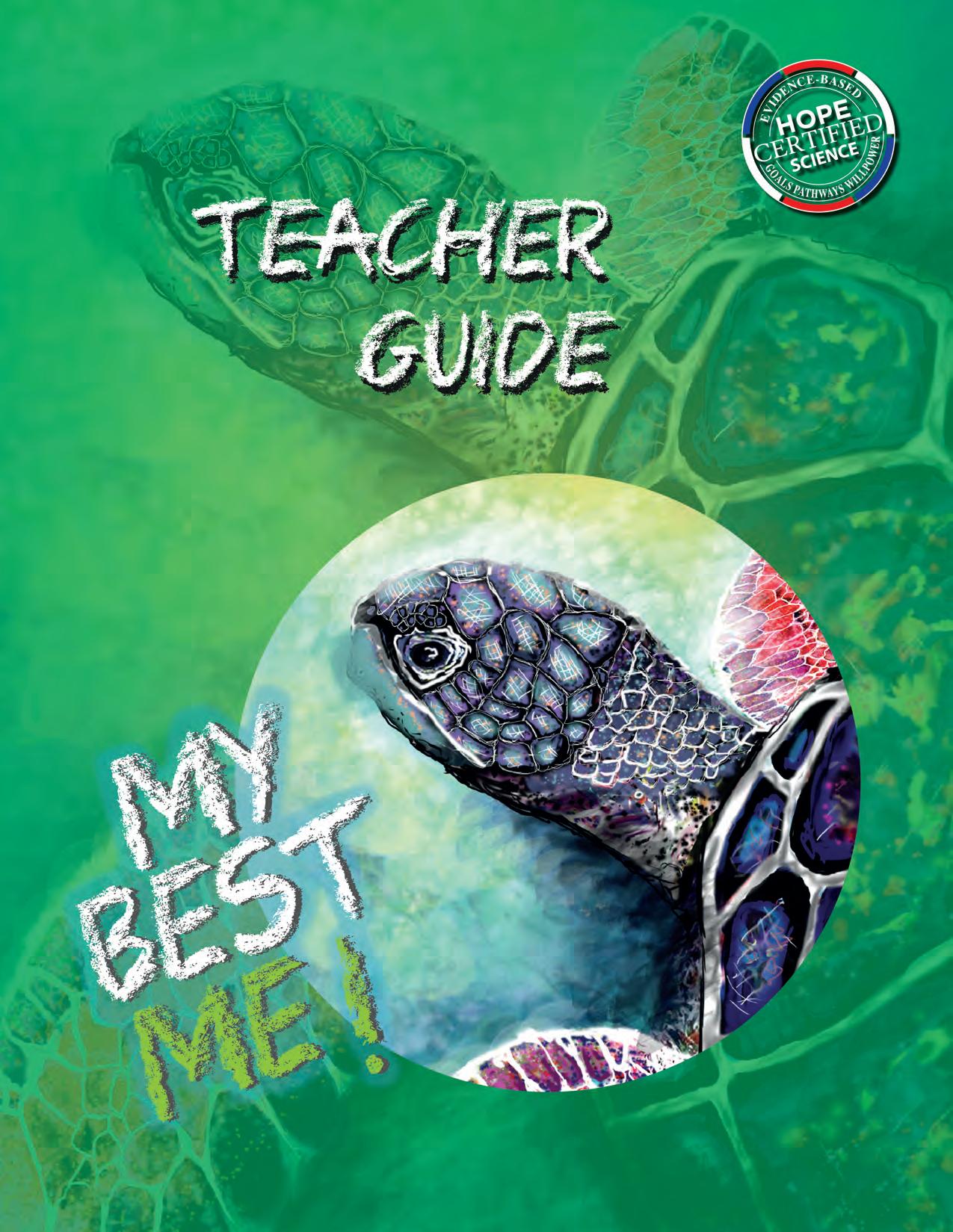




Hope is the belief that the future will be better than today and that you play a role in making it possible. It is not wishful thinking. Hope allows you to identify goals you value, set pathways to achieve them, and employ the willpower to successfully complete those goals you have chosen.
My Best Me is a series of lessons designed to stimulate students to discover their true identity and purpose. My Best Me delivers hope through implementation of a Social Emotional Learning (SEL) methodology that has shown to enhance students’ cognitive competence and give them the integrated skills they need to deal effectively with daily challenges in an ethical, effective manner. My Best Me incorporates both intra- and interpersonal conversations as well as other participatory experiences into five core competencies powered by seven principles. Your investment in elevating hope will result in greater and more enthusiastic student participation, uninterrupted classroom instruction time, and a superior learning environment.


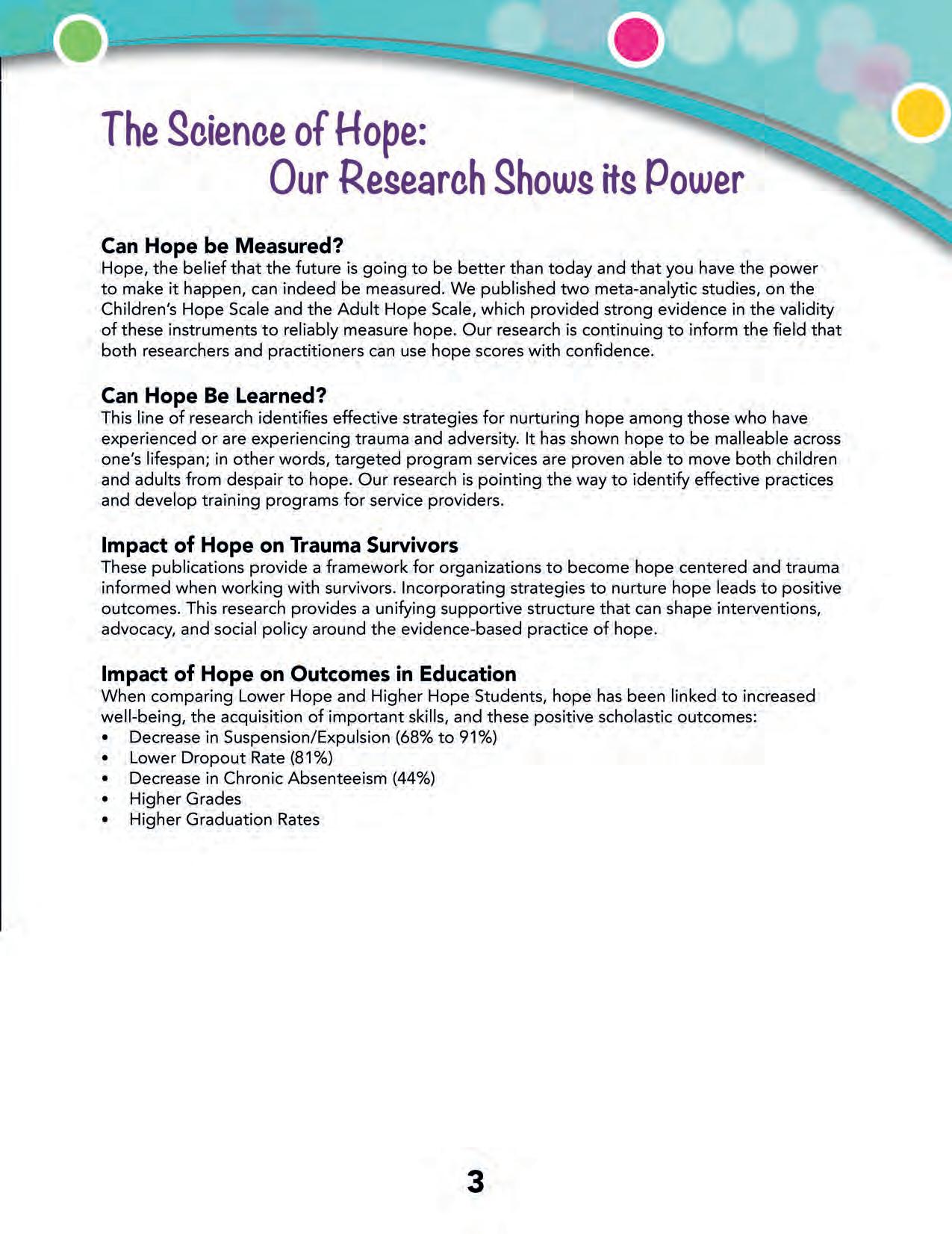



SUMMARY: Discover how the force of hope can help students with their social emotional learning
MATERIALS: My Best Me textbook, writing utensils, journal, paper, audiovisual equipment RESOURCES: Video: Hope Works Link - 4yu.info/?i=95011
SUMMARY: Discover the value of their unique features and some of their personal data MATERIALS: My Best Me textbook, writing utensils, journal, paper, crayons, coloring pencils, other artistic materials to decorate their names.
SUMMARY: Discover how they are a gift with their specific characteristics, personalities, and traits.
MATERIALS: My Best Me textbook, writing utensils, journal, paper, crayons, coloring pencils, audiovisual equipment RESOURCES: Video Book: Jack’s Talent by Maryann Cocca-Leffler - 4yu.info/?i=92031
SUMMARY: Discover how to create a better surrounding by genuinely being concerned for others
MATERIALS: My Best Me textbook, writing utensils, journal, small poster-size (legal size) paper, crayons, markers, audiovisual equipment
RESOURCES: Video Book: Do Unto Otters: A Book About Manners - 4yu.info/?i=92041
Lesson 5: I Am Honest ................................................................................................... 20
SUMMARY: Discover how being honest and truthful eliminates complications in life
MATERIALS: My Best Me textbook, writing utensils, journal, paper, crayons, coloring pencils, audiovisual equipment
RESOURCES: Video Book: Howard B. Wigglebottom and the Monkey on His Back by Howard Binkow, and Susan F. Cornelison - 4yu.info/?i=92051
Lesson 6: Special People in My Life ............................................................................... 22
SUMMARY: Discover how family gives us connections and a place of belonging

MATERIALS: My Best Me textbook, writing utensils, journal, paper, crayons, coloring pencils, audiovisual equipment, card paper and decorating supplies
RESOURCES: Video Book: Love is a Family by Roma Downey - 4yu.info/?i=92061
Lesson 7: I Will Intend to Do it
SUMMARY: Discover the ability of their brain and the power of never giving up
MATERIALS: My Best Me textbook, writing utensils, journal, paper, coloring pencils, string, clothespins, milk jugs or other bottles with small openings, audiovisual equipment
RESOURCES: Video Book: The Most Magnificent Thing - 4yu.info/?i=92071 Video: “Growth Mindset for Students - Episode 2”- 4yu.info/?i=92072
Lesson 8: I Think Before I Act .........................................................................................
SUMMARY: Discover how to put the brakes on the emotions by becoming aware of inner feelings
MATERIALS: My Best Me textbook, writing utensils, journal, paper, slips of paper with emotions, a bag or hat, audiovisual equipment
RESOURCES: Video Book: Howard B. Wigglebottom Learns It’s OK to Back Away - 4yu.info/?i=92081

SUMMARY: Discover how caring for their body allows them to operate effectively.
MATERIALS: My Best Me textbook, writing utensils, journal, paper, crayons, audiovisual equipment
Video: Personal Hygiene by BrainPOP - 4yu.info/?i=92092
SUMMARY: Discover how powerful words are; they can build up or break down.
My Best Me textbook, writing utensils, journal, paper, crayons, construction paper
SUMMARY: Discover how their senses collect data, but they decide how to react to the data collected.
MATERIALS: My Best Me textbook, writing utensils, journal, paper, crayons, coloring pencils audiovisual equipment
Video Book: What Does It Mean to Be Present? by Rano DiOrio - 4yu.info/?i=92111

SUMMARY: Discover the three unique aspects of our being and how to appropriately care for each part.
My Best Me textbook, writing utensils, journal, paper, coloring pencils
SUMMARY: Discover that a wonderful way to deal with emotional pain is to forgive and ask forgiveness.
MATERIALS: My Best Me textbook, writing utensils, journal, paper, a stuffed animal
Video: What is Forgiveness by Stephanie Bierman - 4yu.info/?i=92131
SUMMARY: Discover the value of creating healthy habits in all areas of their life.
MATERIALS: My Best Me textbook, writing utensils, journal, poster paper, markers
SUMMARY: Discover the value of contributing to their communities and participating with what goes on.

MATERIALS: My Best Me textbook, writing utensils, journal, paper, markers, 2 dry sponges, 2 bowls of water, red and black ink
RESOURCES: Article: Attached is a link with great ideas on how to involve students with all that happens inside the classroom - 4yu.info/?i=92151 Lesson
SUMMARY: Discover their ability to help others by attentively paying attention and courageously offering help.
MATERIALS: My Best Me textbook, writing utensils, journal, paper, color pencils markers, crayons, construction paper, yarn or stretchable cord, scissors, hole puncher, materials to decorate the masks
SUMMARY: Discover that rules are tools to protect and improve everyone’s life.
MATERIALS: My Best Me textbook, writing utensils, journal, paper, color pencils, markers, crayons, audiovisual equipment
RESOURCES: Video Book: Watch the story Rules Don’t Apply to Me by Julie Cook - 4yu.info/?i=92171 Lesson 18: Staying Safe Online
SUMMARY: Discover that the digital world has many benefits as well as dangers, therefore caution is needed.
MATERIALS: My Best Me textbook, writing utensils, journal, paper, markers, audiovisual equipment
RESOURCES: Video Book: Watch the story Clicker the Cat: Online Safety Book for Kids by Kyla Cullinane4yu.info/?i=92181
Lesson 19: We Share the World

SUMMARY: Discover that the world is very diverse and that by being open and respectful we can live in harmony.
MATERIALS: My Best Me textbook, writing utensils, journal, paper, markers, audiovisual equipment, access to library or internet
RESOURCES: Video Book: Same, Same, But Different by Jenny Sue Kostecki-Shaw - 4yu.info/?i=92191
Lesson 20: Kindness Is Contagious
SUMMARY: Discover that kindness is contagious and it is a great way to influence their communities.
MATERIALS: My Best Me textbook, writing utensils, journal, paper, coloring pencils, markers, audiovisual equipment
RESOURCES: Video Book: Be Kind by Pat Zietlow Miller and Jen Hill - 4yu.info/?i=92201
SUMMARY: Discover the many ways they can contribute to caring for the environment.
MATERIALS: My Best Me textbook, writing utensils, journal, paper, markers, access to library or internet, audiovisual equipment
RESOURCES: Video book: How to Help the Earth—The Lorax - 4yu.info/?i=92211
Lesson 22: Strong Connections
SUMMARY: Discover how foundational (ground) support is a necessity for all living creatures.
MATERIALS: My Best Me textbook, writing utensils, journal, paper, markers, audiovisual equipment
RESOURCES: Video: The wise, the silly and the foolish little pigs - 4yu.info/?i=92221 Lesson 23: Sounds All Around .......................................................................................

SUMMARY: Discover that the world is full of sounds and that the sounds they produce should be pleasant.
MATERIALS: My Best Me textbook, writing utensils, journal, paper, slips of paper with names of fruit on them, audiovisual equipment
RESOURCES: Video Book: Decibella and Her 6-Inch Voice by Julia Cook and Anita Du Falla4yu.info/?i=92231 Lesson 24: Caring for Pets
SUMMARY: Discover that caring for a pet is a disciplined responsibility, but that a pet can greatly increase their joy.
MATERIALS: My Best Me textbook, writing utensils, journal, paper, audiovisual equipment
RESOURCES: Video: What do pets need? - 4yu.info/?i=92241

SUMMARY: Discover that money is a tool they need to learn to manage at an early age
MATERIALS: My Best Me textbook, writing utensils, journal, paper, crayons or coloring pencils, audiovisual equipment, copies of Printable Chart for Activity (see Resources section)
RESOURCES: Printable Chart: 4yu.info/?i=V598233 Video book: Little Critter: Just Saving My Money by Mercer Mayer - 4yu.info/?i=92251
SUMMARY: Discover that time is a non-renewable resource that can be invested or squandered
MATERIALS: My Best Me textbook, writing utensils, journal, paper, crayons, marker, coloring pencils, clock, watches, calendars, timer, audiovisual equipment
RESOURCES: Video: A powerful lesson on time management 4yu.info/?i=92261 Lesson 27: How to Serve Others
SUMMARY: Discover that there is great satisfaction in sharing themselves through products and services with their communities


MATERIALS: My Best Me textbook, writing utensils, journal, paper, crayons, marker, coloring pencils audiovisual equipment RESOURCES: Video: Life Vest Inside: Kindness Boomerang - 4yu.info/?i=92271
SUMMARY: Discover that by being creative, they can increase their resources
MATERIALS: My Best Me textbook, writing utensils, journal, paper, audiovisual equipment, milk, sugar, vanilla, zip lock bags (big and small) salt, ice
Video: Ice cream in 5 minutes - 4yu.info/?i=92281
SUMMARY: Discover that being diligent and disciplined from the start is far more efficient and effective MATERIALS: My Best Me textbook, writing utensils, journal, paper, rubber bands, bucket(s)
SUMMARY: Discover that reaching their dreams is possible by setting goals, finding pathways and building willpower
MATERIALS: My Best Me textbook, writing utensils, journal, paper, audiovisual equipment
RESOURCES: Video: Little People, Big Dreams: Stephen Hawking by Maria Isabel Sanchez Vega4yu.info/?i=92301

READ
A story, a poem, a saying, or a script that adds to the subject
To obtain knowledge, insight, and understanding through information
To look, see, find, watch, and discover more
To paint, color, or make in a personal manner
PLAY
Engage in an experience and discovery together
WRITE

To write, mark, or sketch personal ideas or discoveries
APPLY
To bring into action, put to use, and demonstrate understanding
GIVE
A contribution, present, or surprise to share with others
ACT
A task that involves direct experience and action
Discuss, consider, or examine certain subjects
Think, ponder, meditate or wonder about important issues
LISTEN
To learn, write, sing, or listen to a song; enjoy a harmony of sounds
CONCLUDE
A closing statement on the lesson subject with a final thought
WATCH
Watch a clip or film section and analyze the information
My Best Me textbook, writing utensils, journal, paper, audiovisual equipment
Resources



Introduction Parent: 4yu.info/?i=V598540
Student Worksheet: 4yu.info/?i=V5982010
Family Engagement: 4yu.info/?i=V5982510
Student Pledge: 4yu.info/?i=V598541
Video: Norman and Lisa - 4yu.info/?i=92011
Hope is the belief that the future is going to be better than today and that each of us, personally, have the power within us to make it happen.
In our society, we often hear the word “hope” used, but generally, it is used in terms of wishful thinking, which is not the definition of hope. Hope is not a feeling or dreaming, but a way of thinking about the future and your role in achieving your goals and bringing the change you long for into your circumstances.
The simplicity of hope is that it is teachable and, therefore, measurable. Hope is the ability to set goals, identify the pathways to achieve those goals, and the capability to dedicate the mental energy (agency) to acting on those pathways and reaching your set goals. Hope is not wishful thinking; rather, hope is about taking action to pursue your goals.
When we understand that increased hope levels predict greater and better outcomes of success and that the steps to increasing our hope are so simple, hope should arise. My Best Me is a tool in your hand to support your students in building their hope through a social emotional learning process.
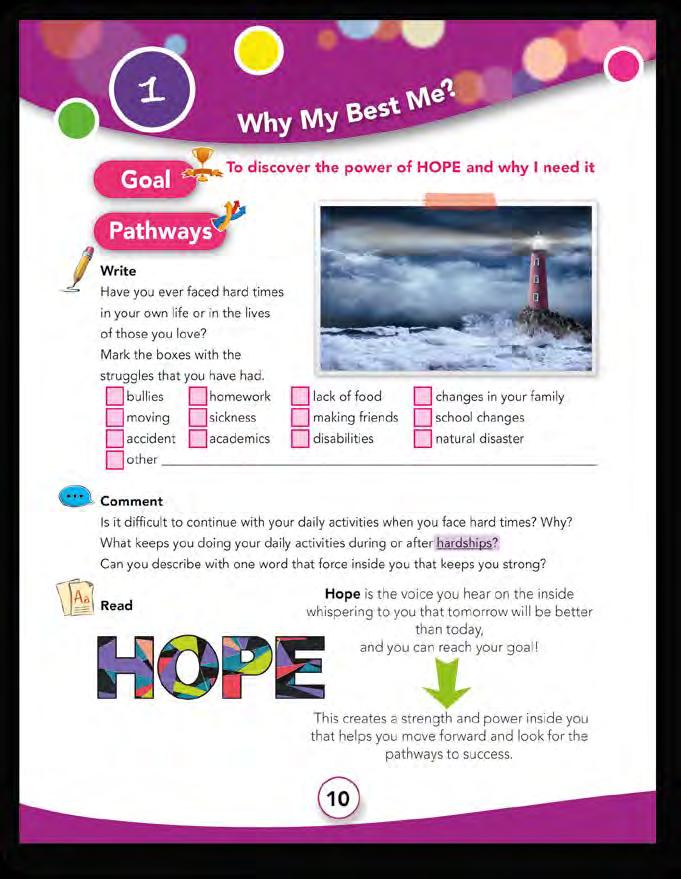
Students will be introduced to the My Best Me textbook and learn how to build hope through a social emotional learning process
Write: Before we talk about hope, students will indicate some of the struggles they might have experienced or are experiencing in their lives. These are exactly the reasons they need hope. To be able to go where we want to go, we need to know where we are.
Comment: These questions are designed to help students discover what kept them going when things were so difficult in their lives. Can students identify hope as the force that kept them strong and
moving on? Ask students what hope means to them, and where and how they have encountered hope in their lives.
Read: Students will adjust their mindset toward hope and realize that hope is the single most important element for change to happen in their lives on a short and long-term basis. Hope is something that is within their control. They will need to learn to take the simple steps addressed in the lesson.
Observe: Encourage students to take some time to page through the My Best Me textbook and discover what it is about. Then have them look up the definition of hope, on pages 2 and 3 in their textbook.

Understand: Because we are addressing social emotional learning, we should not be taken by surprise when emotions surface in some or maybe all of your students, and that social frictions might occur during some of these lessons. That is exactly what this subject matter is focused on. It is wise to be prepared when you do these lessons. “Measure the

mood” to know where your students are emotionally. If you sense possible frictions, take action to set up your class in such a manner that you will be able to manage your students and their reactions.
Apply: Because of the sensitive issues that will be addressed and the information some of the students might share, a confidential student pledge has been attached (see link: 4yu. info/?i=V598541) to invite students to commit to being a trustworthy classmate and signing the agreement.
Watch: Have your students watch this beautiful clip on how a blind dog saved a young girl. Once they have seen the video, talk with the class on where they saw hope in the video and if both Norman and Lisa had hope.
Reflect: This is an opportunity to consider if what the students learned in this lesson changed their perspective on hope. To put the lesson into action, immediately ask students to set one goal they will commit to accomplish. Ask each student to write something down that they can achieve and how they can achieve it. Some ideas may be things related to classroom behavior, study habits, reading books, cleaning their rooms, sharing, etc.
Students should know that they are responsible for building their hope by taking the simple steps of setting goals, identifying pathways and developing their willpower.
My Best Me textbook, writing utensils, journal, poster paper, markers
*Suggestion: you could read Oh, The Things You Can Do That Are Good for You: All About Staying Healthy (Cat in the Hat’s Learning Library) by Tish Rabe. Resources
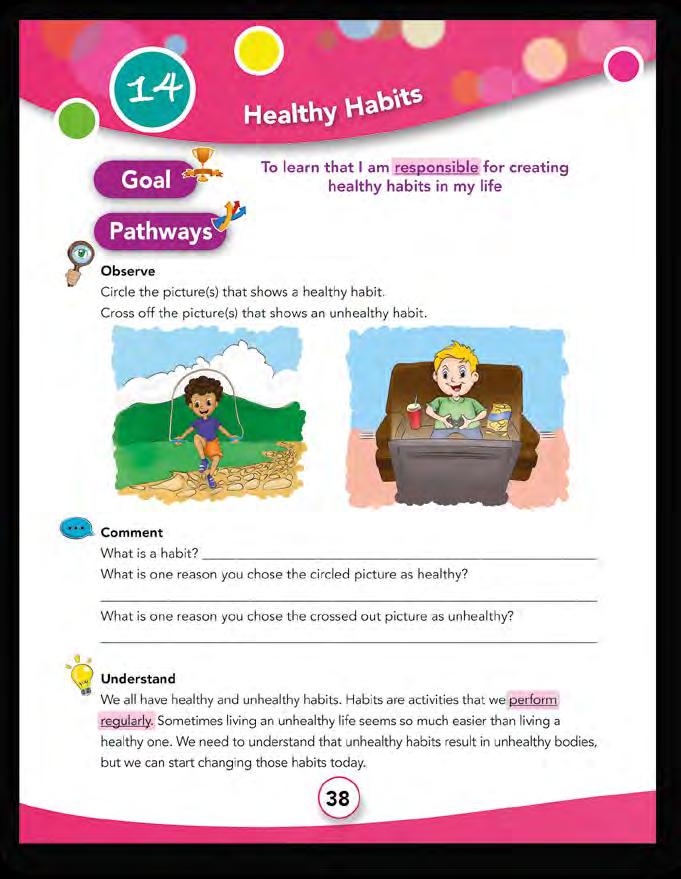


Student Worksheet: 4yu.info/?i=V598214
Family Engagement: 4yu.info/?i=V598264
Glossary

responsible, perform, regularly, motivate
Motivation
We have all developed both healthy and unhealthy habits in our life. The key is to develop more healthy habits to experience an increase in our energy and overall wellbeing. Developing healthy habits is not easy and students might perceive, like many of us do, that living unhealthy seems easier, tastier, cheaper and more entertaining. Why? Because it is. We can just surrender to the unhealthy desires of our undisciplined body, but that often leads to pain and sickness.
Help your students change by making it fun. Set a goal to make your class the healthiest of the school. You will not only notice a change in the overall health of the students, but also in their academic performance, attitude, conduct and behavior. Developing healthy habits has a domino effect in all areas of life.
Remind them that change is an ongoing process, not an event.
• Approach change from a positive perspective • set a good example • involve the whole class and even their families • choose healthy rewards (picnic outside, visit to the zoo, share with younger students, etc.) • start small and steadily expand • be specific with what habit they want to develop. (Take a 20 min. walk 3 times a week) • stay involved in the process, by giving it your daily attention.
Students will understand that although it is difficult, it is vital to develop healthy habits and that they are responsible to do so for themselves.
Observe: Give the students time to circle the picture that portrays a healthy habit and cross off the picture that portrays an unhealthy habit.
Comment: Discuss that a habit is a usual way of behaving. Have students share what some of their habits are. Perhaps begin by sharing one or two of your own to get them started.
There are different aspects to consider in each picture. #1 - being outside, being active, learning and developing coordination skills. #2 - being inside, being
sedentary, consuming a sugary drink, unhealthy snacks, screen exposure. Discuss these different aspects. Have students reason why they answered the way they did. Be careful to not pass judgment on anyone’s habits, just educate on what is healthy and what is unhealthy. You want them to feel free to continue sharing their opinions.

Understand: Gently take the discussion in the direction of their habits. Do they do what these images reflect and what are their thoughts on the results of those habits on their health? Invite students to share some healthy and unhealthy habits that they have. You could make a list on the board to support visual learning and preparing for the change they will be applying.
Apply: Explain to the students that developing a new habit is not an easy task. It takes a lot of time, discipline and dedication to develop (or break) a habit; it does not happen overnight. Read with the students the advice on making a healthy habit. As you do so,
have a practical example ready to show the students how this process works. As you go through the 10 pointers on the green note pad page in the student textbook, use a practical example of establishing a healthy habit to show them how these steps look in action.
Write: The students will match the habits listed to the pictures. This will get the students thinking about a healthy habit that they would like to develop. Discuss with the students why each of these things is a good habit to have. You can ask them about more examples, like reading books (how many per week), making puzzles (Sudoku, crossword, table puzzles), polite manners (saying please, thank you, excuse me etc.).
Reflect: The students will make a plan to start a new healthy habit. They will write the habit that they created in their workbook in the space provided or in their journal. Help the students answer the question of why they want to develop this specific habit.
Then they will make a motivational poster for themselves to help encourage them to follow through on their habit. Remind the students that they have a month to create the habit together with the other students who have also chosen a habit to develop.

My Best Me textbook, writing utensils, journal, paper, color pencils, markers, crayons, audiovisual equipment
Resources
Student Worksheet: 4yu.info/?i=V598217
Family Engagement: 4yu.info/?i=V598267
Video Book: Watch Rules Don’t Apply to Me by Julie Cook - 4yu.info/?i=92171
signs, rules, prevent, accidents, destination, neighborhood, obey
The streets around us have a lot of movement. There are people walking on the streets, with bicycles, cars, and buses going in many different directions. Road signs were developed to manage the movements of drivers, passengers and pedestrians. Their purpose is to:


• keep people safe
• create order on the roads and in traffic
• develop a smooth traffic flow
• provide essential information for the drivers
• help people reach their destination on time
Generally, most road signs send a clear message, even to foreigners, because they use images to convey the message they want to send. However, it is our job, no matter where we are, to understand what those signs mean (color, shape, message) as well as obey the signs around us, not so much because we have to (which is true), but because it keeps us safe. When we obey the signs, we keep ourselves and others safe.
Students will understand the importance of traffic signs as well as rules anywhere and be motivated to obey them, to keep everyone safe.
Observe: The students will guess the purpose of each sign together as a whole group. Allow for multiple students to give their input.

Comment: Discuss the questions in the workbook as a class. The students will think about where they have seen each of the signs and the purpose for having signs like the ones in the workbook. Have the students think about why the signs have pictures on them and who the signs were made for. Were they made for pedestrians or the
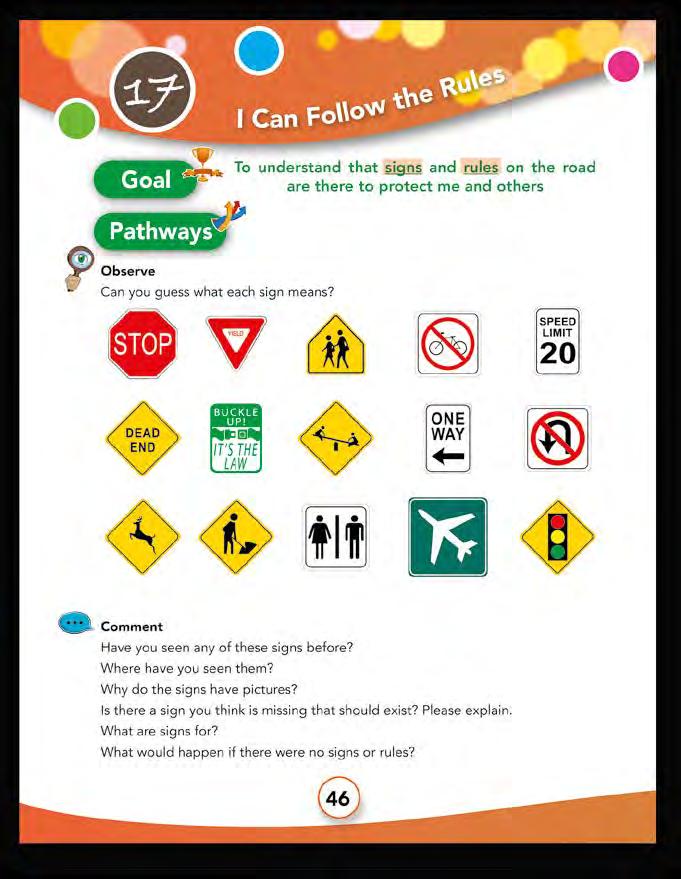
people driving? Students should have the insight that the signs are there to give instructions, help people get to their destination (on time) and keep people on the roads safe.
Watch: Watch the reading of Rules Don’t Apply to Me by Julie Cook. Allow students to give their observations on what they saw and heard.
Understand: Have the students visualize what the streets around them look like. What vehicles do they see? Are there people walking or on bicycles? Is it calm or busy; sunny, rainy or snowy; day or night? Discuss the importance of the time of day and weather on the activity on the streets. To keep everyone moving in an orderly and safe manner, there are signs to help guide people. If everyone follows the signs, there is a far greater chance that everyone will be safe. Ask students to share some of the safety rules they follow that don’t have signs (for example: stopping at each driveway and making sure a car is not coming out, stopping and holding an adult’s hand when crossing a road or in a parking lot, never walking
behind a car) Explain that sometimes there is no sign, but students can still be careful by watching for things that might warn them of danger (driveways, crosswalk, cars moving in parking lots, white back up lights on a car, turn signals of an approaching car, etc.).

Have students share if they think rules apply to them or if they have ever ignored certain signs or rules.
Act: The students will look at the picture of the neighborhood in the workbook. The student’s job is to decide which signs they would add to this neighborhood to make it orderly and safe. The students should notice that there is no warning of a crossing, stop sign or stop light. The cars would all run into each other at the intersection without them. Students may also notice that there is no speed limit sign. Without a speed limit sign, cars can go as fast as they can which could be dangerous. Finally, the students may want to add a school zone sign, parking sign or pedestrian crossing signs.
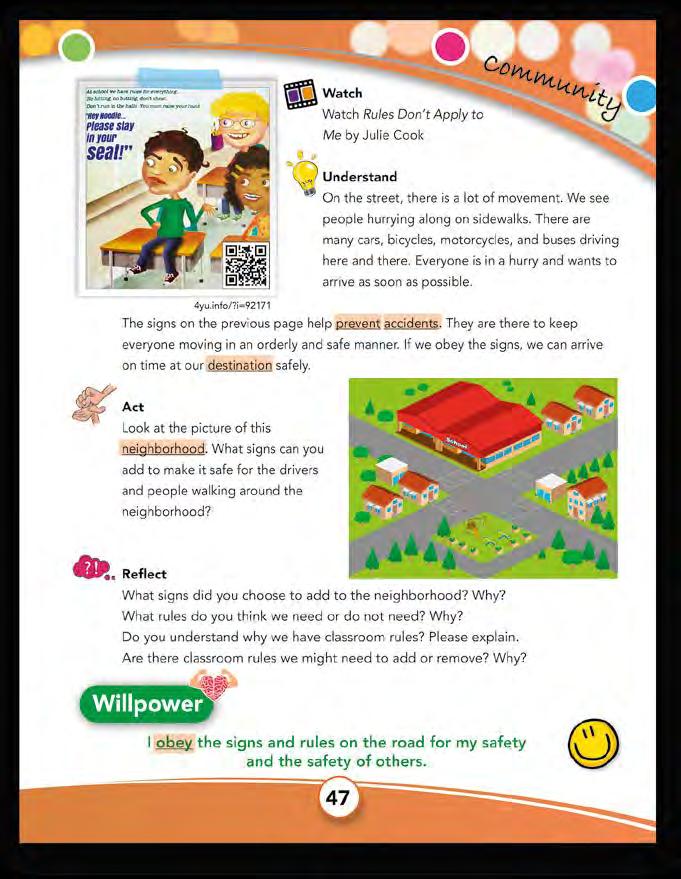
Reflect: The students will talk about the picture of the neighborhood. First talk about some of the problems this neighborhood might have as it is in the picture. If many people live there, what kind of problems could develop, etc. The students can share with each other what signs they decided to add to make the streets safer and more orderly.
Ask students if they now appreciate rules more than before and why.
The students understand the importance of road signs and the value of obeying the signs for everyone’s safety.
My Best Me textbook, writing utensils, journal, paper, slips of paper with the name of a fruit on them, audiovisual equipment
* Suggestion: you could add to the lesson by reading The Wump World by Bill Peet.
Resources
Student Worksheet: 4yu.info/?i=V598223
Family Engagement: 4yu.info/?i=V598273
Video Book: Decibella and Her 6-Inch Voice by Julia Cook and Anita Du Falla4yu.info/?i=92231
Glossary
object, praise, encouragement, bothersome, odors, sales-person, irritate, version, gently, volume



Motivation
Students will learn about sound pollution. Just like water and air are polluted with particles, space can be polluted by sound waves. Some sounds are pleasant, like calm music or a bird singing. Other noises are bothersome and unpleasant, like a dog barking, a loud motor, or a digital game. We can also pollute our surroundings with our words and tone of voice. When we say something that is not kind, when we scream in anger or frustration, when we cuss and curse, we are affecting all that is around us, as well as ourselves, in a very destructive manner.

There are consequences to the words we use and, just like with littering, we might not see and experience the consequences right away, but it’s coming. When we hurt people with our words, we are destroying something inside of them. Words are like seeds, sown into the lives of others. Our seeds will result in a harvest; we will reap or get what we sowed. If we sow ugliness, destruction and negativity, that will be our harvest (multiplied). If we sow friendliness, encouragement and positivity, that will be our harvest. We get to choose what we want coming back to us, and our words and tone of voice reflect our choice.
The students will learn not only how to control the sounds they make, but also the words they use and the tone of voice they select.
Write: To make students aware of the many different noises they hear daily, let them look at the pictures in their workbook and draw a line from the sound to the object that produces it. Review their answers with them. What is the purpose of sound?
You can expand by asking students to share with the class what sounds annoy, bother or hurt them and why these sounds are unpleasant to them.
Watch: Watch the reading of Decibella and Her Six-Inch Voice. Why were people annoyed with
Decibella? Verify students’ understanding that volume impacts the message we send to others by asking, “Do you think people are annoyed with the sounds you make at times? What kind of sounds, and why?”

Understand: Read this section together. Make a list on the board of pleasant sounds and unpleasant sounds. Have students fill in the list with their ideas. (There might be different opinions, that can lead to further discussion.) Make another list with kind and unkind words and tone of voice. Again, have the students fill in the lists. This will help them become more aware of how full our surroundings are with noises.
Play: The students will form a tunnel standing in a line facing toward each other and linking hands above their heads. Each student will be assigned the name of a fruit that they are going to yell out at the top of their voice, all at the same time, trying to sell their fruit. Give some students a ‘grocery list’ with the name of one fruit that they must go through the tunnel
to “buy”. They must listen for the one who is trying to sell them that particular fruit. The purpose of this activity is to see how unproductive noise pollution can be. It is overwhelming when everyone is yelling at you at the same time.
Then have the students form the tunnel again while students go through one at a time while students whisper something nice about the student going through the tunnel. Evaluate with the students their different experiences and how they felt during both exercises.
Comment: Use the workbook questions to guide students in a conversation about the activity they completed. They should understand that there might be an appropriate time to use loud voices, like when they are at a sporting event or playing a sport outside. However, when your voice is not used appropriately, and the words you use are hurtful, it is noise pollution that is bothersome and damaging to others. Discuss how the different noises can make them feel comfortable or uncomfortable and why.
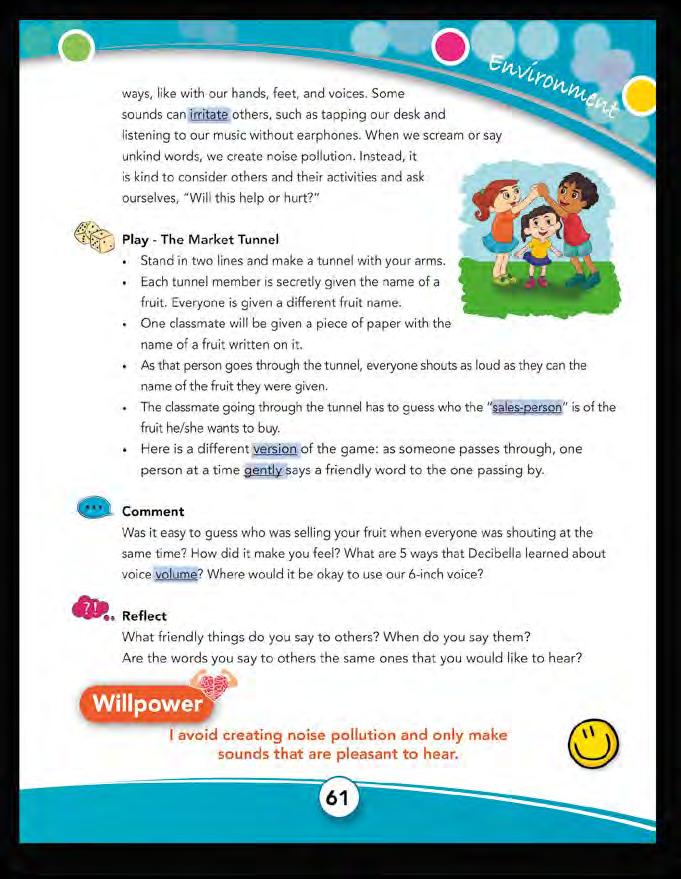
*Suggestion: You could let them listen to some music that creates anxiety and then listen to music that brings peace and tranquility.
Reflect: Students should complete the reflection questions in their journal or on a piece of paper. You can invite them to share their responses with the whole class or with a partner.
Students understand that sounds and their volumes can either be pleasant or unpleasant. They understand the impact of pleasant and unpleasant sounds and are committed to doing their part to improve the sounds in their environment.
My Best Me textbook, writing utensils, journal, paper, audiovisual equipment
Resources



Student Worksheet: 4yu.info/?i=V598230
Family Engagement: 4yu.info/?i=V598280
Video: Little People, Big Dreams: Stephen Hawking by Maria Isabel Sanchez Vega4yu.info/?i=92301
achieve, dreams, obstacles, overcome, interfere, pursuit, positive, confidence, compliments, original
We all have a dream of what we wish to achieve in our lifetimes. A dream helps us discover our drive and the wealth of potential we have inside of us to make it happen. A dream helps us direct ourselves in how we could be living our lives. A dream helps us decide what is important in life and what we are living for. It adds significance and meaning to our lives.
As important as dreaming is, making it a reality requires the courage to act and work hard to achieve it. There is a Japanese proverb that says “vision without action is a (day)dream and action without vision is a nightmare.” Dreams give us vision, but students need to learn that dreams only come true through deliberate and purposeful action; that is a requirement. Dreams are the seeds for HOPE. Hope requires students to set goals, which helps them determine where they are going, the first step of getting on the move. They have to discover how they are going to achieve their dreams through the pathways they choose. And of course entwined through it all is the willpower to keep going, get back up, overcome obstacles, until they reach their set goals and fulfill their dreams and visions.
Students will understand that if they set goals, find pathways and apply their willpower, diligently working hard and never giving up, they can achieve their dreams.
Observe: The images reveal a story of a young boy’s dream of teaching his dogs tricks to perform in a circus and the obstacles he had to overcome. He refused to give up until he had a circus act with his dogs.
Comment: These questions serve as a guide to help them better understand the pictures. Help the students relate to this boy’s dreams. Help them to understand that through hard work and diligence they can achieve any goal they set, just like what happened with the young boy.
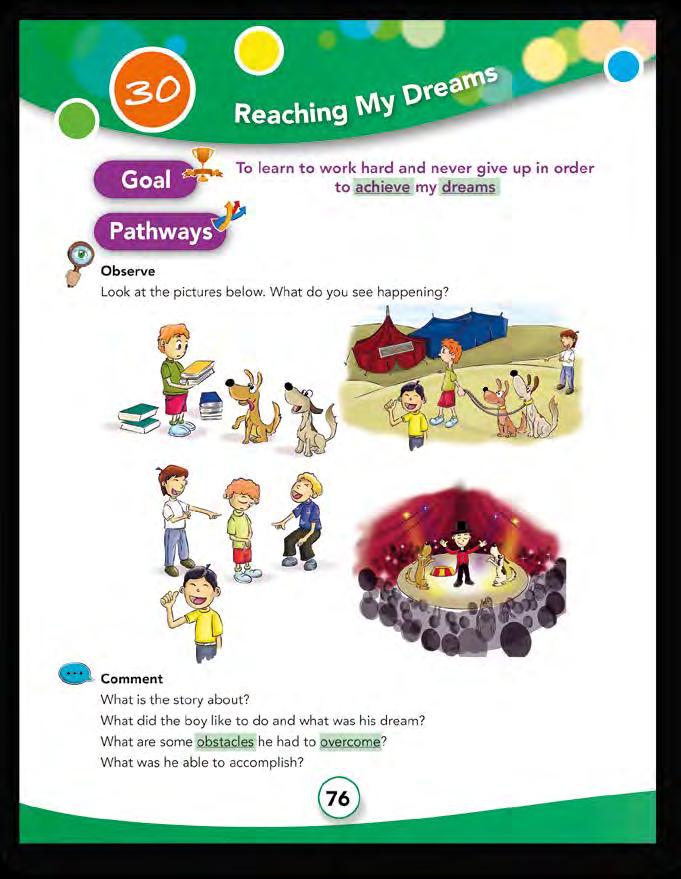
You could talk about how the behavior of the other children might have affected him, but he didn’t allow it to stop him. He probably felt hurt, embarrassed, discouraged, angry, and lonely, but he did not let those negative and destructive feelings, and the opinions of others keep him from living his dream. He was passionate about what he wanted to do. He liked training and working with his dogs and did it on a consistent basis. He was good at teaching his dogs. He diligently kept pursuing what he wanted to do and in this story we see he ended up doing what he wanted deep in his heart. Students should understand that others are not the reason we fail to fulfill our dreams. It is the negative emotions and thoughts within us, and our giving in to them that become the obstacles to reaching our goals. We can be our own worst enemy.
Video: Watch the reading of Little People, Big Dreams: Stephen Hawking by Maria Isabel Sanchez Vega. Ask the class to discuss the questions provided.
Understand: We all have dreams and visions.
Some are long-term like going to college or a certain career. Some are short-term like improving a skill or making the basketball team. These dreams need to be transferred to goals, pathways and will power. It will require hard work to turn dreams into reality. There will be obstacles that affect them, but they cannot stop them if they do not allow them to.
Act: Have each student write down their name and one goal or dream on a piece of paper. Each student will pass their paper around, in a designated order, and classmates will write words of encouragement and/or compliments on the pages they receive. The teacher should collect the papers when done to review the comments and then return the papers to the original owner. These papers give students positive words to keep them motivated during hard times. They will also experience personally how important it is to encourage one another and build each other up to be able to fulfill their goals and dreams.
Reflect: The real obstacles that students will have to overcome are their own negative and destructive attitudes, emotions and behaviors. These will sabotage them from fulfilling their dreams if they are not aware of them. How can they overcome these obstacles? Students should understand and practice positive self-talk and be able to recognize their own negative attitudes. Help your students to identify examples of self-talk.
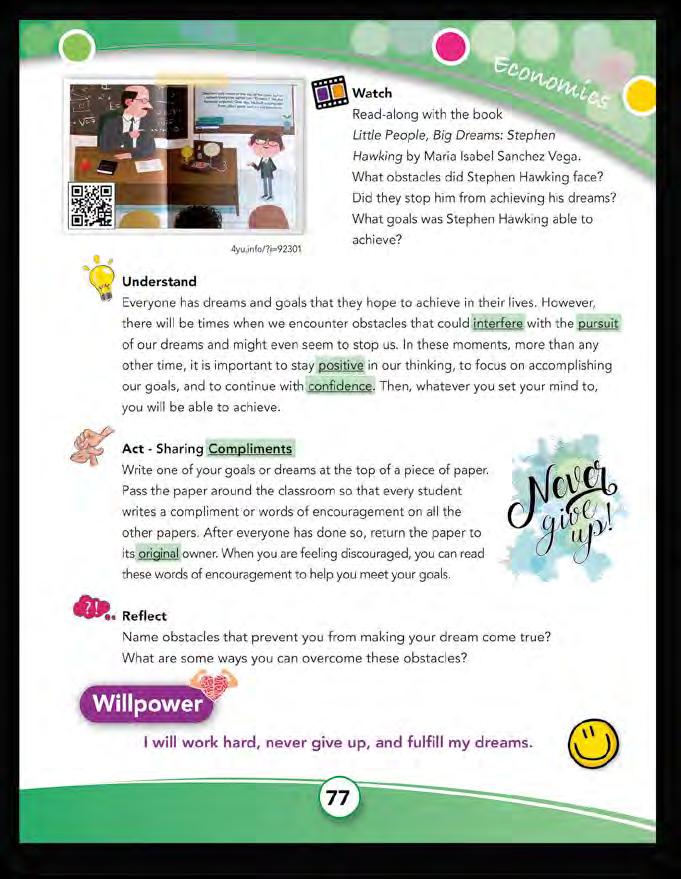

Students realize they can and will fulfill any dream they turn into action steps and that nothing can hold them back from turning dreams into reality if they eliminate themselves as being the obstacle.